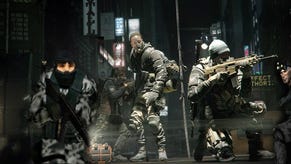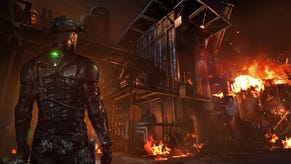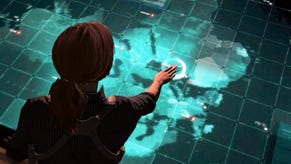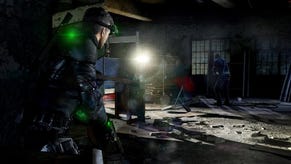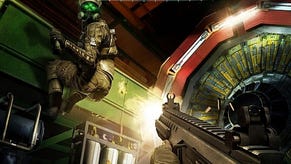Hands On: Splinter Cell: Blacklist
"flying warehouse of espionage"
I gassed a dog, wore its limp body like a stole, and threw the conked canine at a guard. Because of that my trousers are now more tactical, a room on my flying fortress has nicer decorations, and now I'll have more information about missions. Splinter Cell: Blacklist is a bizarre game.
Those aren't direct effects, though. That would be ludicrous. No, they're purchases that Sam can make while he's flying around in his plane. It makes perfect sense in context: Terrorists, known as the Blacklist, are holding the US to ransom. They'll commit an act of awfulness every week until the US basically wipes out its worldwide military presence. They are confusingly named Blacklist, because of reasons. This is a threat forces Sam into the position of leader of Fourth Echelon, the spy group he's had an on-and-off relationship with from the first game. As leader he has perks: Sam, his team, and his informants fly around in a plane, moving from place to place like Scooby Doo in what's basically an upgradeable, flying warehouse of espionage. It's obvious if you think about it.
Everything Sam does seems to have an XP reward. Silence a bad guy, get XP. Crawl through a vent, get XP. That's what Sam spends in the upgrade menu, aboard his sky fortress. Everything can be added to. His trousers can have a different weave to enhance movement, his gloves can be upgraded to help with weapon handling; the goggles start off in a basic night vision set-up, but after only one mission I had enough to add a few upgrades, kitting them out the in wall-splitting enhance-o-vision. In colour. The plane, of all things, can have more comfortable rooms fitted so an informant on board is happier. Fluffier pillows will make him more open with his information. It's like the Geneva Convention has its own Innovations catalogue.
It's telling that all I've focused on the ridiculous steps in the upgrade tree. For all Blacklist adds, and there really is a hefty amount, almost everything else is a remix. It's an echo of Splinter Cells past. The floating text returns. Classic vs multiplayer and the excellent co-op is back. The pantherish additions to Sam's moveset keep him as lithe and lethal as he was in Conviction, but he can now use mark and execute, the instakill meter that you build with stealth kills, while on the run.
Everything's tried and tested, so it's up to Ubisoft to make the challenges fun. That's where concern coshes my enthusiasm. I panicked when I loaded up Blacklist, because it felt like the shadow Sam was using to hide was being cast by Uncharted: it wobbled between movement and cut-scene in awkward lurches, launching me into Sam's body after a helicopter crash and ending on moment where I snuck past patrolling guards on a night time patrol. This isn't really a mission, but a tutorial. I scrambled out of cover, they screamed that they'd spotted me, and the game unceremoniously yanked me into a cut-scene. It wasn't the only time the game just dropped a cut-scene with a clang, either.
The second mission also had problems. This time it was a wander through Benghazi in the daytime. I get the impression that the story missions for Blacklist will be focussed, with what I experienced feeling more like first-person shooter levels than a stealth game: dragging the player through corridors and into open areas filled with guards. An ever-present dot on the HUD was leading me onwards, not really letting me revel in the space provided. When it tried to get more interesting, it did so clumsily. The ending of that mission was a short but tedious fight against waves of guards.
Things are a bit better away from the story. From the mission control hub, Sam has access to single-player missions, co-op missions, and multiplayer. There's no distinction: the map clumps everything together so tightly that you can even see friends on there. I'd hoped to try out the Spy vs Mercs, but a crash put paid to that. Instead I was invited into a co-op mission. These side-mission might help you in tangential ways in the main story, though in this case it was just a quest to take out all the guards.
It was also an open level. The context of it wasn't made clear to me, because a producer hurriedly set it up to give me something to do: it was vaguely middle-eastern, with guards patrolling at multiple heights. There were enough walls to hide behind, enough patrol routes that give you time to shift from one cover to the other. In this situation things are a lot more fraught and interesting, and you can see the guard AI at work. They call-in to each other a lot more, so if someone goes missing on patrol fellow guards will break off and hunt. I took one guard out who was on a radio, and it set the others into a cautious panic. We had to hide the body and retreat into the dark.
Splinter Cell has always been an excellent co-op game, and this was no different. There were a couple of sneak routes, one accessed via a co-op boost, that we used to split up. We could take on anyone in any order, though this particular level had two open areas next to each other. It's fun, timing moves with other spies, hearing a grunt off camera as a partner panthers someone to death. And it's truly co-op: I found myself on a ledge with a viewpoint, and below was a helmeted heavy enemy. He's only vulnerable from the back, and there were a few other guards below. She didn't have an upgraded spy, so I talked the other spy through the route she needed to take that wouldn't alert everyone. When it was done, we had enough mark and execute tags to finish the level with a flourish.
I had a very brief play of a final mission that I plucked from the on-plane map: a Sea Fort off the coast of London that the terrorists were using for data transfer. It loaded up. I was in the dark. I could ponder my next move without any worry. It felt, briefly, like the Splinter Cell of old. I eked my way past a guard on a pier and headed towards a door. I was informed that I'd need another player to open it. Hrrm. I backtracked, looking out for the solo player route. Then I was spotted, and instead of allowing me to panther my way out of it, the mission was over, and my time was up. Really, Ubisoft? That was an notion that your own series started with, but by the third game it was being mocked by Sam's leaders.
Oh, I'm a bit grumpy. There were moments that it struck a chord, and the co-op game I played was ace. The versus multiplayer breaking on me was very frustrating, and when I looked mournfully up at the people playing it everyone was having a blast. I will buy this game for that multiplayer, and I can already tell that'll be enough. But singleplayer has problems: whether it's a big glowing icon dragging you on, or a ridiculous selection of trousers in the inventory, there's something demanding about Blacklist. A need to hurry the player along. I miss the calm, Michael Ironside-voiced Sam, sat in the dark, complaining about everything.







